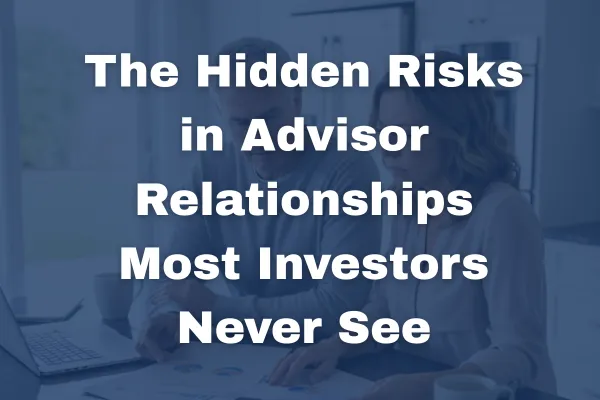
The Hidden Risks in Advisor Relationships Most Investors Never See
The Hidden Risks in Advisor Relationships That Go Unseen
(Why Quiet Misalignment — Not Market Volatility — Is the Real Threat to Wealth)
“Most investors assume the biggest risk to their money comes from the market. It doesn’t". - Paul Powell
Markets rise and fall, but over long periods, they compound predictably.
What damages wealth far more consistently — and quietly — are the structural risks inside the advisor relationship itself.
These risks don’t come from bad people or bad intentions.
They come from an industry built on compensation models, vague processes, and marketing-driven priorities that were never designed with the investor’s interests at the center.
Here are the three risks almost every investor is exposed to — and almost no one is taught to see.

1. Misaligned Incentives (The Most Expensive Risk in the Industry)
If you asked most investors how their advisor gets paid, they couldn’t tell you.
And that’s where the problem starts.
Asset-Based Fees Create Built-In Conflicts
When an advisor charges 1% of assets under management (AUM), their revenue grows automatically as the market grows — even if they deliver no additional value.
Your portfolio goes up → your fees go up → but the workload stays the same.
No other professional relationship works like this.
Worse:
AUM fees create a structural incentive for advisors to keep your money with them at all times.
Meaning:
If you want to invest in a small business → conflict
If you want to buy real estate → conflict
If you want to pay off the mortgage → conflict
If you want to diversify outside traditional markets → conflict
Anything that reduces assets reduces their revenue — and that can quietly shape the advice you receive.
Commissions Create Even Harder Conflicts
Some investment products — especially variable annuities — can pay advisors 6%, 7%, even 8% commissions.
That means your “$500,000 financial plan” could come with a $40,000 incentive behind the scenes.
Again: not illegal.
But undeniably misaligned.
Why This Matters
Misaligned incentives lead to misaligned advice.
And misaligned advice compounds against you over time — far more than market volatility.
This is the #1 hidden cost in financial advice today.
2. Underperformance That Never Gets Measured (The Silent Loss Most Investors Never Notice)
Most investors judge success by one thing:
“Is my account higher than it was last year?”
That’s not performance.
That’s just market participation.
True performance is measured relative to a benchmark, net of all fees.
What a 1% Underperformance Really Costs
Let’s use simple math.
Portfolio A earns 9% (reasonable long-term market return)
Portfolio B earns 8% (just 1% lag — common with high-fee strategies)
Starting with $1,000,000 over 10 years:
Portfolio A → $2,367,364
Portfolio B → $2,158,925
Difference: $208,439 lost — from just 1% per year.
And here’s the kicker:
Most advisors charge roughly 1% themselves.
Meaning many investors begin each year already 1% behind the benchmark before a single investment decision is made.
That’s why underperformance is the hidden cost that compounds backward — quietly, consistently, and without any visibility.
3. Inconsistent Process (The Slow Fade from “Engaged” to “Reactive”)
One of the industry’s unspoken truths is this:
Most advisors spend more time trying to get new clients than serving existing ones.
Marketing → seminars → networking → referrals → social media → content → CRM management.
All of that takes time.
And too often, it comes at the expense of oversight, analysis, and proactive management.
Here’s what inconsistency looks like in the real world:
No documented weekly, monthly, or quarterly investment processes
No written evidence of analysis, research, or manager review
No meeting summaries or follow-up notes
No documented risk reviews
No clear investment policy statement
No tracking of whether promised actions actually occurred
Ask an advisor:
“Show me what your team did for client portfolios in the last 30 days.”
Most can’t.
Not because they don’t care — but because the industry rewards marketing, not documented process.
And when process fades, performance usually follows.
Why These Risks Go Unseen
Investors rarely ask hard questions because:
The industry taught them not to
Talking about fees feels uncomfortable
Comparing advisors feels awkward
Most people don’t know what to look for
They assume “no news is good news”
They don't have a measurement system
They trust the relationship more than the structure
But trust without verification is how good people end up with decades of missed compounding — and never realize what happened.
What Smart Investors Are Doing Now
Modern investors are shifting from blind trust to structured oversight, built on:
Full transparency of how advisors are paid
Benchmarking performance net of fees
Written processes and deliverables
Documented meeting summaries
Clear investment policy statements
Regular risk and allocation reviews
Systems to verify, not just assume
It’s not adversarial.
It’s not distrustful.
It’s responsible.
It’s how institutions have made decisions for decades — and how investors can protect themselves today.
Closing Thought
The biggest risk to your wealth isn’t the market.
It’s a relationship built on assumptions, unclear incentives, and unmeasured performance.
Once you understand the hidden risks, you can see the advisor relationship clearly — and protect the wealth you’ve worked your entire life to build.
Next Step: Access the Full Framework
Download “Financial Self-Defense”
The complete 27-question checklist that helps you apply the Evidence-Based Hiring™ process with institutional rigor.